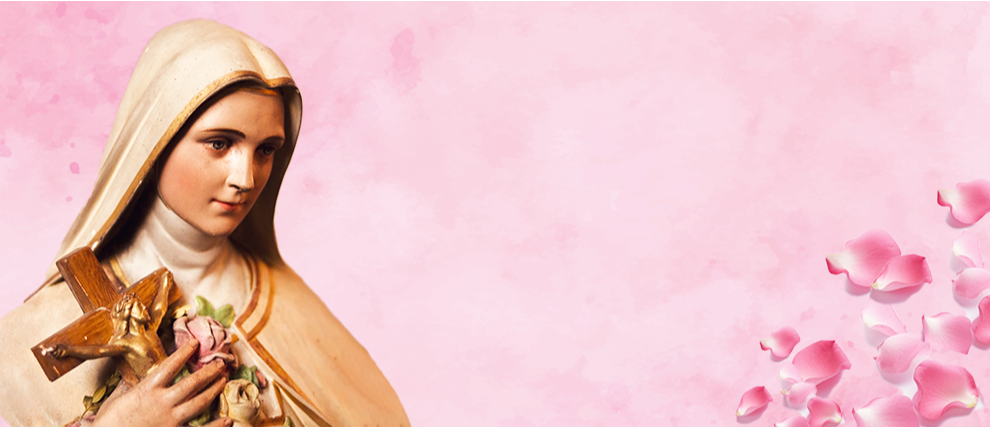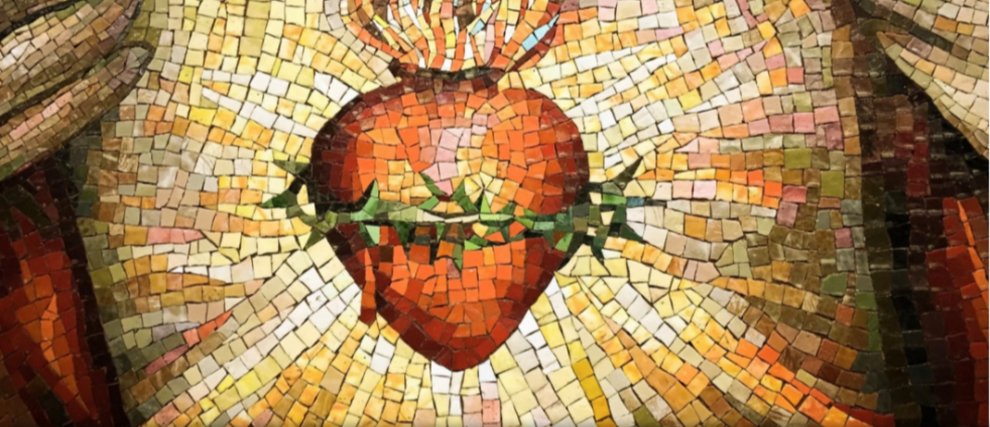Saint Thérèse of Lisieux
Biography of Saint Thérèse of Lisieux
Françoise Marie Thérèse Martin was born on January 2nd, 1873 in Alençon. She was the last of nine children of Louis and Zélie Martin. Her mother died when she is 4 years old, and this left a deep wound in little Thérèse. She, who was a cheerful little girl with an impetuous character, who, after the death of her mother, became "shy and gentle, and overly sensitive." In 1877, her father moved with his daughters to Lisieux, living with the Buissonnet family. When Therese was nine years old, her sister Pauline, who had played the role of second mother, entered the Carmel, followed by her sister Marie. The departures of those who raised her reminded Thérèse of the feeling of abandonment felt during the loss of her mother.
In 1882, Therese fell ill and suffered from discomfort and headaches. Her condition rapidly worsened. The family, very worried, prayed to Our Lady of Victories. On May 13th, 1883, Thérèse’s sisters, gathered in prayer, turned to the statue of the Virgin. Thérèse, who prayed with her sisters, saw the Virgin smiling at her. From that moment on, she was perfectly healed. On Christmas 1886, she received a conversion that brought her out of childhood and progressed her spiritually. In 1887, at the end of a Sunday Mass, Therese received the revelation of her mission: “saving souls through prayer and sacrifice.”
At the age of fifteen, Thérèse also wished to enter the Carmel. The superior of Carmel was formally opposed to it because of her young age. Her father took her to Rome, where she had an audience with Pope Leo XIII. At her request to give her permission to enter the Carmel, he said to her: “My child, do as your superiors decide.” In April 1888, Thérèse finally entered the Carmel. She took the name of Sister Thérèse of the Child Jesus and of the Holy Face, and she pronounced her final vows two years later. Her sister Céline also entered the community, and her sister Léonie entered the order of the Visitation. Sister Thérèse of the Child Jesus was quickly confronted with the harsh life in the Carmel. She said: “I found religious life as I had imagined it… my first steps met more thorns than roses.” In 1894, Therese discovered her path and went so far as to offer herself to merciful love on June 9, 1895, through her act of offering. At the request of her sister Pauline, Mother Agnes of Jesus, she began writing her childhood memories, which would become part of "Story of a Soul."
On the night of the Thursday before Good Friday in 1896, Thérèse began to cough up blood. She perceived it "as a gentle and distant murmur which announced to me the arrival of the Husband". From this moment on, she was plunged into thick spiritual darkness from which she would never emerge. Therese was afflicted with tuberculosis and her health was rapidly deteriorating. She was placed in the infirmary, where she withstood her suffering resolutely and without complaining, offering it for the salvation of souls. At the request of the Mother Superior, she wrote her memories of a Carmelite using her last strength.
She died on September 30th, 1897 at the age of 24, saying "I’m not dying, I am entering life." From then on, a “rose rain” would spread over the Earth, according to Thérèse herself. These are all the miracles that would take place after her death, especially at her grave.
The writings of Saint Thérèse of the Child Jesus
Autobiographical manuscripts: Story of a Soul
After Thérèse's death, Mother Agnes (her eldest sister, Pauline) gathered Thérèse's writings into a collection entitled “Story of a Soul.” This collection includes three autobiographical manuscripts that describe the spirituality of Thérèse of the Child Jesus.
The poems of little Thérèse
Sister Thérèse of the Child Jesus wrote many poems for feasts, for her sisters, or simply to express her love for the Lord. These poems reveal Thérèse's spiritual evolution as well as her struggles and sufferings. The poems of Saint Thérèse are composed not to be read, but to be sung. At the Carmel, they were sung on famous tunes of the time. Even today, they are performed and set to music by artists of various styles. Some of the most famous are: "Living with love", "Throwing flowers", "My song today ", "My weapons", "Why I love you, O Mary", "Love is giving everything", "I if I had committed...".
The Prayers of Saint Thérèse
Saint Thérèse wrote many beautiful prayers, in which she gave free rein to her heart and to her impulses of love for Christ. She said herself: "For me, prayer is an impulse of the heart, it is a simple look into Heaven, it is a cry of gratitude and love within trial as well as within joy... ” There are 21 written prayers by Thérèse, and many others scattered in her other writings. Among the most famous prayers of Saint Thérèse of the Child Jesus are her Act of Offering to Merciful Love, Homage to the Most Holy Trinity, Mystical Flowers,” Prayer to Jesus in the Tabernacle, and Consecration to the Holy Face.
Quotes from Saint Thérèse of the Child Jesus
Among all the writings left by Saint Therese, many precious quotations still nourish the spiritual life of thousands of Christians today. Here are some of them:
"I want to spend my time in Heaven doing good on Earth", "After my death, I will bring down a shower of roses on Earth", "I will return to Earth to make Love loved".
“What a sweet joy to think that God is righteous, that is to say that He takes into account our weaknesses, that He knows perfectly well the fragility of our nature. What would I be afraid of? ”
“My path is one of trust and love, I do not understand souls who are afraid of such a tender friend.”
“The only happiness on earth is to strive to always find delightful the part that Jesus gives us.”
The Writings of Saint Thérèse of Lisieux
Saint Thérèse is known for her Little Way; in her search for holiness, she understood that it was not necessary to perform heroic acts. It is in the Bible that Therese found her spiritual orientation. Two passages strongly challenged her: she read in Proverbs 9:4, “Let all who are simple come to my house!” and said, "then I came to ask myself what Jesus would do to the little ones who would come to him.” She also read Isaiah 66 and understood that the more she recognized herself as small and weak in Jesus' arms, the faster he would take her to heaven as holy. From this she drew her famous image of the ladder and the elevator: she understood that she could not climb her ladder alone to go to heaven but that Jesus himself would take her in his arms as a fast elevator. Thérèse began to see all the perfections of God through his mercy.
The Fame of little Thérèse
While she died unknown in the convent, Saint Thérèse became world-famous and revered. There are many prayers to Saint Thérèse, novena, miraculous novena, prayer of healing, miraculous prayer. We can also participate in “rose petal evenings.” All of these are offered to everyone to meet little Thérèse and ask for her intercession.
Sister Thérèse of the Child Jesus was canonized on May 17th, 1925 by Pius XI, 28 years after her death. She is celebrated on October 1st. She is the patroness of AIDS patients, aviators, and florists. In 1927, Pius XI proclaimed Thérèse patroness of missions, alongside Saint Francis-Xavier. This pope himself said that Saint Thérèse of Lisieux was the star of his pontificate. He hoped that a large and magnificent basilica would be built. Today, the Basilica of Lisieux is the second-largest place of pilgrimage in France after Lourdes.
In 1944, Pius XII declared her the secondary patroness of France, along with Jeanne d 'Arc. On October 19, 1997, on the centenary of the death of Saint Thérèse, Pope John Paul II proclaimed her a Doctor of the Church. Countless priestly and religious vocations would emerge from a meeting with little Thérèse. A host of priests and missionaries entrusted her with their ministry. Today, more than 50 congregations in the world claim to be of the spirituality of Saint Theresa.

